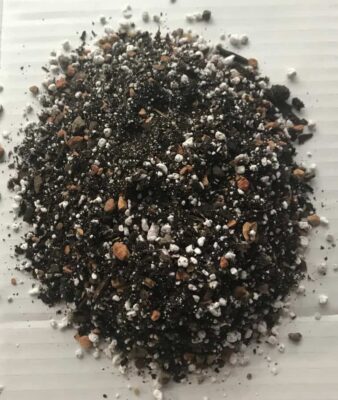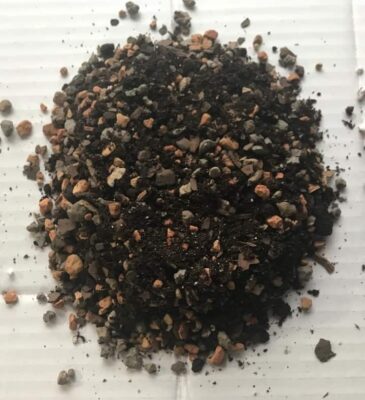This post contains affiliate links.
Cacti make wonderful houseplants! They are generally easy to care for and look beautiful in your home. So often you can buy one, place it in a sunny spot in your home and almost forget about it except for a little water now and then– and it still thrives!
Eventually though, your cactus will need to be repotted, and regular potting mix is not a healthy choice for your cactus since it can promote root rot and other problems. So the question often asked is what is a good cactus soil mix, and what is in it?
A good cactus soil mix is one that is well-aerated and with excellent drainage. The soil should contain a gritty, porous mixture of mostly inorganic material, with just enough organic material to provide some moisture while also allowing it to quickly dry after watering.

Cacti require a different type of soil mix than what you would use with other houseplants. There are some very good reasons for this, which we will talk about, but you need to use a proper cactus soil mix to keep your plant healthy.
What Type of Soil is Best For Your Cactus?
The best type of soil for your cactus is one that mimics the type of soil from their native environment. So the question also is, what type of cactus do you have?
This is important to know since there are different types of cactus plants with different types of soil needs.
The two main categories of cactus plants are:
- Desert Cacti – Some examples are barrel cactus, moon cactus, bunny ear cactus, and old lady cactus.
- Tropical Cacti – Some examples are Christmas cactus, Thanksgiving cactus, and Easter cactus.
These two types have slightly different needs when it comes to soil conditions, but overall, they both need soil that drains quickly and doesn’t hold moisture for too long.
If you are interested in learning about what soil you need for other types of succulents, we have an article here called A Beginner’s Guide to Making Succulent Soil at Home
Desert Cacti
Cacti roots are generally shallow and are designed to quickly take advantage of any rain that occurs; absorbing water when it comes and storing the moisture in the fleshy pads or parts of the cactus. But since they are so efficient at absorbing this water, this is also why they are susceptible to root rot when they are overwatered.
This is why a proper cactus soil mix should be one that has good aeration and quickly drains. You want the proper amount of moisture provided to the cactus so it can be absorbed, but then you also want it to dry out quickly between waterings so there won’t be any root rot or other problems.
Tropical Cacti
These types of cacti come from South American rainforests and they are found living between the branches of trees. They are epiphytic plants– non-parasitic plants that grow on other plants.
In their natural habitat, they get more water than desert cacti do but just like their desert-dwelling cousins, they don’t like their roots to be wet for too long. They need soil that quickly drains, but they do need a little more organic matter in their soil than desert cacti since they don’t need their roots to dry out completely between watering.

Good cactus soil ingredients and characteristics
These are some of the ingredients you will find in a good cactus soil mix. Not all of them are necessary, and some ingredients work better than others. But in general, you will find various mixtures of these in a good cactus soil mix.
Inorganic Materials:
Inorganic materials are what provide the aeration needed to allow air exchange into the soil. They also help the soil quickly drain, allowing it to dry out so it doesn’t hold onto moisture for too long.
- Coarse sand and grit – This sand is not the fine sand you would find in a sandbox, but a coarser sand with more of a pebble-like texture. Some may call it grit instead of sand.
- Fun fact: Desert cacti need a higher amount of coarse sand and grit than tropical cacti.
- Perlite– Perlite is a type of volcanic glass. If you’ve ever noticed the white ingredient mixed into your regular potting soil— that is perlite! You can easily crush it with your fingers. It is also used to help prevent compaction in the soil.
- Gravel or lava rock(pumice)– These are coarser ingredients that make the soil loose and prevent compaction.
- Vermiculite – This ingredient may cause water retention issues if too much is added, but it is used in some mixes. It is very lightweight and allows for better aeration of your soil.
- Turface – This is a high-fired calcined clay, and is often used with bonsai plants. This is a coarse material that not only absorbs moisture but promotes good drainage too.
- Hard Japanese Akadama – This is similar to clay, but is actually a type of volcanic clay that is mined in Japan. It’s used a lot with Bonsai, as well as succulents and cacti.
Organic Ingredients:
This is the part of the soil that holds the nutrients and holds onto some moisture. Your cactus needs some organic materials in its soil and won’t thrive very well in inorganic materials alone.
- Peat Moss – This is used to help hold some moisture and will lower the soil’s pH level. The problem with peat moss is that it is hard to hydrate when it is bone dry and when it is wet it retains the moisture for a long period of time. So a little goes a long way; you don’t want to have too much of this in the mix.
- Fun Fact: Tropical cacti need more organic ingredients like this in their soil mix.
- Coconut Coir and Composted Rice Husks – These are alternatives to peat moss and are more eco-friendly. They absorb water well and dry out quickly too, which is what we need for cactus soil.
- Potting soil – This can fall into both the inorganic and the organic ingredient category but I put it here since it usually has some peat moss or other organic material in it. Just as with the Peat moss, a little of this goes a long way.

Choosing The Perfect Commercially Made Soil For Your Cactus
Once you’ve determined what type of cactus you have, you can buy a Cactus soil mix from your local garden center or even online.
High-quality cactus soil mixes made by specialty nurseries are generally the best choice for your cacti.
Lesser quality soil mixes made by or sold in your local box stores may not have enough of the coarse inorganic ingredients included and they may also have too much of the organic ingredients.
If you buy commercially made cactus soil and find out that it doesn’t have enough of the coarser ingredients, all is not lost. If you find that to be the case, you can easily mix in some more grit, pumice, or other inorganic materials to improve drainage. So in essence, you will be modifying the soil to better suit your cactus’ needs.
Some of the good brands are available online and I have listed a few of them here; you can check them out if you wish. They have very good reviews.
- Dr. Earth
- Superfly Bonsai
- The Succulent Cult
- Hoffman’s
- EB Stone
- Tanks, and Bonsai Jack.
I found one on Amazon that works very well with my cactus plants. I have used and recommend Bonsai Jack Succulent and Cactus soil. It is a very gritty soil mix!
If you want a commercial soil mix that costs less and want to settle with a lesser quality mix, you can do what I did with this soil from Amazon. Since it was on the heavy side, I just added in some extra perlite to improve the drainage and it also works well with my cactus plants.
You Can Make Your Own Cactus Soil Mix From Scratch
Alternatively, you can make your own soil mix from scratch, which is not hard to do at all. If you have a lot of cacti to repot, it would be cheaper to mix your own cactus soil. You will spend more upfront to buy each of the individual ingredients, but you will be able to make a lot more soil and ultimately save money.
Another advantage to making your own soil is that you will know exactly what ingredients you have used and can easily make adjustments to your recipe to meet your plants’ needs.
If you are interested in learning how to make your own cactus soil, we have an article here.
We also have a couple of related articles one on how to make your own succulent soil at home and another that answers the question of whether you can mix cactus soil with regular potting soil.
This post was written for cactus-central.com and is not permitted to be used on other sites.

